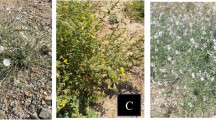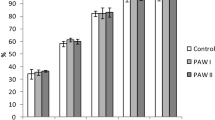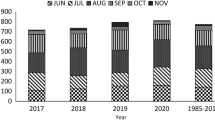Abstract
SEVERE water shortage, particularly in the early stages of tuber development, results in secondary growth of potato tubers1,2. The resultant crop may then contain a high proportion of misshapen and cracked tubers3–5. These conditions are often aggravated by a low plant density5,7. Work here shows a marked similarity in the development of the stems of marrow stem kale when water shortage occurs during the early stages of growth.
This is a preview of subscription content, access via your institution
Access options
Subscribe to this journal
Receive 51 print issues and online access
$199.00 per year
only $3.90 per issue
Buy this article
- Purchase on SpringerLink
- Instant access to full article PDF
Prices may be subject to local taxes which are calculated during checkout
Similar content being viewed by others
References
Nielsen, L. W., and Sparks, W. C., Res. Bull. No. 23, Univ. Idaho Agric. Exp. Sta. (1953).
Robins, J. S., and Domingo, C. E., Agron. J., 48, 488 (1956).
Toosey, R. D., M.Sc. thesis, Univ. Reading (1960).
Toosey, R. D., Eur. Potato J., 5, 23 (1962).
Whitehead, T., McIntosh, T. P., and Findlay, W. M., The Potato in Health and Disease, 744 (Oliver and Boyd, London, 1953).
Rieman, G. H., Cooper, D. C., and Rominsky, M., Amer. Potato J., 30, 98 (1953).
Rieman, G. H., Res. Bull. No. 191, Univ. Wisconsin (1955).
Author information
Authors and Affiliations
Rights and permissions
About this article
Cite this article
TOOSEY, R., SMITH, R. Influence of Spacing and Level of Nitrogenous Fertilizer on Stem Cracking and Lodging in Marrow Stem Kale. Nature 202, 924–925 (1964). https://doi.org/10.1038/202924a0
Issue date:
DOI: https://doi.org/10.1038/202924a0



